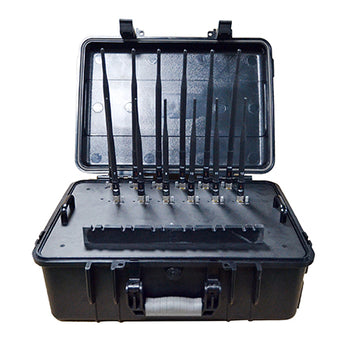In the face of drone attacks, use drone countermeasures
Drone technology offers us the possibility to change the world - from a historic shift in e-commerce to faster emergency response. But the technology also has its dark side. It can be used to surveil, threaten critical infrastructure, or attack crowds and public spaces. "U.S. Homeland Security Secretary Kirstjen Nielsen wrote in The Washington Post.
Venezuelan President Nicolas Maduro was attacked by a drone while attending an open-air event on the 4th. The suspect allegedly operated two drones carrying explosives in an attempt to assassinate him. While the outside world is paying attention to the mastermind behind the scenes, the pros and cons of drones have once again become the focus of public opinion.
Reports have pointed out that if the "assassination" claim is true, it would be the first drone attack on a head of state, and it could be a dire omen for the future. There are also security experts who worry that the threat of drones may become more frequent in the future, and armed groups may even use drones to launch biochemical attacks.
In recent years, the civilian drone market has boomed due to factors such as technological advancement, increasing supply, and falling prices. This emerging electronic product, which combines practicality and leisure, is gradually integrated into people's daily work and life. Small size, light weight, and easy to carry drones can not only complete tasks that are difficult for humans to complete, but also record life scenes and other entertainment functions.
A "quadcopter" is a relatively common type of drone, sometimes referred to as a "quadcopter". These drones can be operated remotely, can fly for more than 20 minutes on a single charge, and are inexpensive and easy to buy. However, the "elf" has a limited load and can easily turn into a deadly weapon, even threatening social security.
Extremist groups have seized the opportunity of technological advancement to innovate tactically. ISIS and other extremist groups have reportedly used drones to carry out attacks, including throwing grenades and ramming infrastructure. With the help of new technologies, extremist groups are able to use low-cost tools to inflict lethal damage on formidable foes. Worryingly, the threat of drones is not limited to the Middle East battlefield.
In January 2015, an out-of-control drone crashed on the White House lawn, sparking fears for the safety of the US president. Shortly thereafter, a drone carrying radioactive material flew into the residence of the Prime Minister of Japan, and it was found that it was a man protesting Japan's nuclear policy. In April, Saudi security forces shot down a drone near the Royal Palace, with reports pointing to a "coup attack".
Some argue that drone strikes by non-state actors have limited impact. Scott Stewart, an analyst at Stratfor security consultancy, pointed out that military drones are extremely difficult to obtain, and homemade bombs are generally much less lethal.
Still, some experts worry that the psychological impact of a successful small-scale attack could far outweigh the actual damage, fulfilling the attacker's goal of spreading terrorism. Extremist groups such as the Islamic State and al-Qaeda have achieved this goal. Colin Clark, an analyst at the RAND Corporation, a policy think tank, points out that this is an important aspect of terrorism — the psychological aspect, where attacks can still provoke fear, even if they don’t result in a large number of casualties.

How to deal with the rising threat of drones
U.S. security agencies have warned that existing laws are insufficient to address the threat of drones, and operators can use unmanned aircraft systems (UAS) to launch conventional and cyber-attacks. “This is a very serious, imminent threat, and we’re not ready to deal with it,” several DHS officials said in congressional testimony in June. Because federal law predates the development of drone technology Promulgated, so the Department of Homeland Security and the Department of Justice are "restricted" in regulating drones.
Dan Gaidinger, deputy director of the Center for Drone Studies (CSD) at Bard College, pointed out that many anti-drone systems, such as "drone jammer" designed to cut off operators from drones, are difficult to operate in non-combat areas. deployment, as such technologies may interfere with commercial flights and law enforcement operations, among others. "There are a lot of challenges to deploying these measures domestically," Gettinger said. Other analysis points out that some UAVs are small in size and low in flight height, making it difficult for radar to detect and identify them. Also, as drone popularity continues to soar, it can be difficult to identify the bad guys from the legion of enthusiasts.
According to reports, the U.S. Department of Security has called on Congress to amend relevant laws to give the U.S. federal government more authority to deal with the drone threat. Germany passed the "Regulations on Regulating the Use of Unmanned Aerial Vehicles" last year, making strict regulations on drone users and other aspects. France also issued a decree on drone management for the first time in 2012, and subsequently revised and supplemented relevant regulations to strictly regulate the use of drones. But Greenpeace said last month that it had steered a drone into a French nuclear power plant, in a bid to warn the public of the dangers of nuclear power.
Although many companies are cooperating with government departments to formulate relevant regulations, will the relevant regulations take effect in a timely manner? Can different departments at all levels coordinate and manage "black flying"? Are management tools and techniques sufficiently advanced?
RAND's Clark noted that governments are struggling to keep up with the rapid development of commercial drones, and "the reality is far greater than the law, the policy and the authority." "Atlantic Monthly" pointed out that Venezuela's "assassination" shows that technology is developing faster than the government's ability to respond.
For this incomprehensible status quo brought by drones, the problems caused by technology should also be solved by technology. As a leading company in the UAV countermeasure industry, topsignaljammer has been focusing on the research of anti-UAV technology for a long time. It has independently developed a mature anti-UAV system, which can accurately handle UAVs in real time. Agencies provide solutions to drone strikes and customized low-altitude support services.













